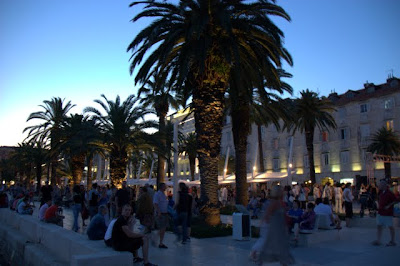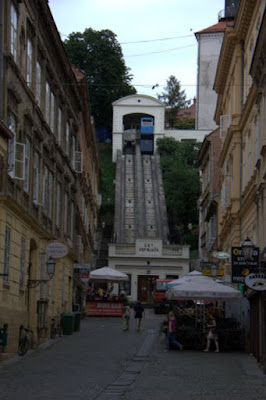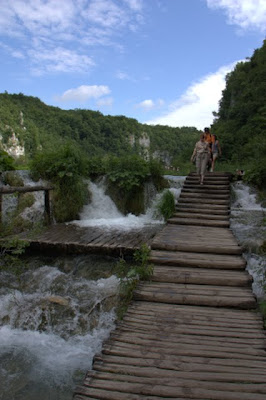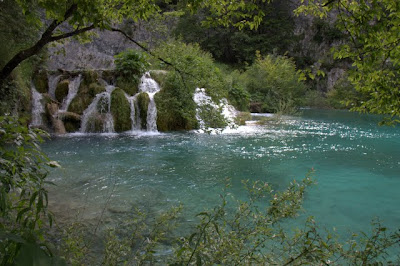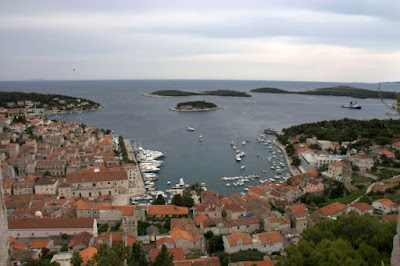Our Two Croatian Lipa
There is a lot of advice on the Internet about the perfect Croatian itinerary. Croatia is a very long, narrow country, which makes it hard to get around. The train system is not extensive, and renting cars are expensive due to an Eastern European surcharge. The eleven hour bus rides we took twice were brutal (once from Pula to Split; once from Dubrovnik to Zagreb). The buses careened around every inch of Croatia’s long coastline. Scenic, yes, but not comfortable. So if you only have a short time in Croatia, it would be best to focus upon one region of the country.
Also, there is no getting around it: Croatia, especially in late June/early July, is full of tourists. For the most part, we didn’t find that spoiled our experience in Croatia, but it like most of Europe, it may be better visited in the spring or fall.
I’ve already told you about our good experiences at Plitvice National Park and on the islands. Here’s our two cents on the other places we have visited:
Rovinj
We only stayed one night in Rovinj, but we would have loved to have tacked on a second night. Rovinj has a church towering high above its old town, with views of the sea below. The old town is filled with narrow alleys with laundry lines criss-crossing above. Steep steps creep between old stone buildings. But most importantly, Rovinj seemed to be much more full of life than our previous coastal stop in Piran, Slovenia. Rovinj’s cafes and restaurants were full, and its steep lanes were dotted with artists’ shops. If your travels bring you to the Istria portion of Croatia, Rovinj is worth a stop.
Something about Pula never clicked with us. Its claim to fame is one of the largest Roman amphitheatres still standing. Seeing the amphitheatre was neat, but it took less than an hour. We personally think Pula didn’t stack up with the other places we visited in Croatia.
Split
Split is probably a necessity in any Croatian itinerary that includes a visit to the Dalmatian Islands from a logistics standpoint, but we found the city to be somewhat bland. At this point in our trip, it takes more than historic old stuff to impress us, and we didn’t find Split to have much of a personality. We did like its outdoor fruit market. Its promenade is fun (albeit with strange talent shows). It is full of hundreds of people, especially at night, even if they probably are all tourists.
Dubrovnik
Everything you read calls Dubrovnik the Gem of the Adriatic. This is probably an accurate description, so you are probably going to find what I’m going to say next to be completely crazy. Contrary to what all of the guidebooks say, I don’t think Dubrovnik is a must see and could be skipped. Now, I know no one is going to listen to me anyway, and that’s fine, because you should decide for yourself. I’m not saying don’t go there, I’m just saying if you don’t have the time, don’t beat yourself up trying to get there is it is fairly far south and there are other areas of Croatia that are just as worthy to visit. The old town is definitely scenic. It is enclosed by walls which you can walk upon. Steep stairs in narrow alleys lead down to a wide, bustling promenade. The city is very clean and well-preserved, especially considering it experienced bombing during Croatia’s war in the 1990s. What I didn’t like about Dubrovnik is that it is hard to find restaurants that do not have inflated prices and food better than mediocre.
Zagreb
We hardly saw any other tourists while we checked out Zagreb. After spending time in coastal Croatia in pretty much the high season, it was refreshing to be in a town where everyone is going about the business of living their daily lives. But if you want a city that is not touristy, you have to take the bad with the good. Zagreb will never win any awards for beauty. Out of all of the cities in the former communist countries we have toured, Zagreb had the most drab, utilitarian communist housing remaining. Other than the central old town area, the neighborhoods are full of huge, high rise buildings, all aging metal and steel. Graffiti is scrawled on the sides. At home, we’d wonder if we were in a ghetto. Here, it is just par for the course. And what can they do? They can’t tear it all down and rebuild solely for aesthetic reasons. But what we noticed the people who live there do make the best of it. Meticulously maintained flowers lined many yards. Hydrangeas are everywhere (making me wonder how my hydrangeas are doing at our old house). Window boxes perched on top of balconies, giving everyone bright spots to focus upon. We enjoyed our time in the city. We ate delicious Croatian chocolate at the Kras bonbonierre (reminiscent of Sarris, for you Pittsburgh folks); we rode Europe’s shortest funicular; we ate a delicious meal at a place using local produce on a lively pedestrian only street; we walked through the city’s green parks; and we visited a funky shop.


Kids these days…
The promenade in Split was the site of one of the most bizarre things we have seen on this trip: the Dan Drzavnosti Little Girl Talent Show. Now, I have no idea who this Dan Drzavnosti is, or what the name of this spectacle was, but his name was plastered all over the stage. We saw a crowd gathering around a stage, and a little bored, we went to check it out.
What we saw was who we assumed was this Dan person singing that uno, dos, tres song in a super flat baritone, while extremely young girls bounced around behind him as he sang, “You know I want you…” Dan didn’t look much older than the girls themselves.
The talent show, if that is what it was, was like a train wreck. Each song got worse and worse, yet we didn’t turn away. There was a young Gwen Stefani, full of sass, singing Hollerback Girl at the top of her lungs, even though she couldn’t have been more than eight.
There was a pint-size rapper, leading his posse with hair that only could have resulted from sticking their fingers in electrical sockets through a rendition of Black Eyed Peas’ song, Tonight’s the Night.
There was a Lady Gaga, singing Bad Romance with a large hair piece and all of the drama her 8? 9? 10? (at most) self could muster.
Then it really got out of control. The next girl got up on stage. She was – maybe – 13.
When she started singing about her lovely lady lumps and do you want the junk in her trunk, I couldn’t take anymore. Doesn’t ANYONE think this is really odd? These girls are so young! Judging by the people cheering by the stage, I guess not.
As I prepared this post, I decided to find out who this Dan Drzavnosti is once and for all. It turns out that Dan Drzavnosti is not a person, but the name of Croatia’s Statehood Day. So apparently this was for a state holiday celebration!
Water wonderland: Plitvice National Park
Our last stop in Croatia was a visit to Plitvice National Park. Apparently, some buses stop there, but from what I read on the internet, taking a bus could be complicated and may involve flagging one down on the side of the road in order to go home. This sounded like more trouble than it was worth, so when we saw an opportunity to rent a super sweet Fiat again for under $40, we jumped at the chance. (Of course, this doesn’t count tolls or gas. One problem with budget cars is they are usually gas guzzlers). Turns out this time, the Fiat was not even made in this decade. And when it was made, it had to be the cheapiest, crappiest car one could buy. Sean: This doesn’t even have power steering! Amy: What does it mean to have power steering?
Plitvice is one of Croatia’s national parks located about 2 hours from Zagreb. It has 16 different lakes, all connected by tons of waterfalls. If we thought the water was turquoise in Slovenia, that is just because we hadn’t seen Plitivice yet. Apparently the lime content in the lakes colors the water various shades of blues and greens. Plitvice is the type of place better explained in pictures than in words, so without further ado:
If you go, consider going to the park late in the day after the tours leave. It only took us about 2 1/2 hours to go through the course that was supposed to take 3 to 4 hours. We also spent about another hour in the park walking up above. The park closes at 7:00, so going around 3:00 or 4:00 will give you plenty of time without most of the crowds.
Tracing Roots
Sean apparently looks Croatian. This was told to us twice. The first time it was by a Croatian man at the table next to us at a restaurant in Split, who shared his very strong wine with Sean. He studied Sean very carefully before he pronounced that Sean had a Croatian head. Sean’s Croatian looks were confirmed in a separate instance by the sister of Maria (one of the non-granny “Grannies”). Sean contends that their pronouncements are meaningless because they only mentioned his apparent Croatian looks after learning that part of Sean’s family is originally from Croatia. Still, they should know.
The Croatian man was wrong about one thing: his proclamation that Sean specifically looked like he was from coastal Croatia. Thanks to Sean’s brother Gary, the keeper of the family history, we learned that Sean and Gary’s great-great-grandfather supposedly was born and died in House 35 in Volavje, a village inland not far from Zagreb, the capital. Sean’s great-grandfather and his grandfather were also born in House 35. Sean’s grandfather came over to the United States in 1921, when he was about 13.
We stopped in Volavje on the way to Plitvice National Park. Driving out of Zagreb, you pass rows and rows of large, ugly communist block apartment buildings, and quickly reach farmland. Although Volavje was only about 25 miles outside of Zagreb, it was a different world.
We noticed that many of the houses appeared to be much, much newer, so we were not sure if House 35 is still standing. Volaje is so small, it still does not have any street names, and each house in the village is numbered. We found the house numbered 35, but there was no way it was old enough to be The House 35.
We did find the church that Sean’s family likely attended, as it has been standing since the 17th century. It was neat to think that his ancestors likely got married and were baptized there.
They also probably had funeral services there, although we were unsuccessful in tracking down any of the headstones marking their graves. Some of the graves in the graveyard by the church were old enough, but most were quite new. It was easy to see which families had a real presence in the town, as their names were repeated over and over on old and new headstones. We did find two more modern graves with Sean’s family’s last name, including one where the husband appeared to still be alive. Many of the graves simply had unmarked crosses, so one of them could belong to Sean’s family. We attempted to chat with the man working in the church, peering at us walking around the cemetery, but he spoke no English.
Tracing roots is pretty fun, even if we didn’t come up with anything too concrete. Future trip idea: tracking down my family and Sean’s maternal side in Germany.
Island Hopping in Croatia
Croatia has a very long coastline bordering the sparkling Adriatic Sea. Off of its coast lie many islands. Although no one knows for sure how many islands there are, there appears to be over 1200 different islands, with about 60 or so with habitation.
Sailboat charters abound. While we yearned to sail on the open sea, we heard the prices were close to $1000 a day: obviously not an option for two budget travelers. Many articles tout the alternative of island hopping by ferry.
In the summers, ferries run from the mainland to the various islands daily. The most common departure cities are Rjeika, Sibenik, Split and Dubrovnik, with Split probably being the most popular due to its proximity of many of the more popular islands. We found that the articles make island hopping sound a little more carefree and simple than it really is. Not every island is connected to each other each day, and some islands are not connected by ferry at all without a trip back to the mainland. With some advance planning, however, the ferries are a cheap way to see multiple islands.
We wanted to avoid having to traverse back to Split, so we chose a route that allowed us to travel continuously. Here was our route and some scoop about each island we chose:
One: Catamaran (a fast ferry) from Split to Hvar Town, Hvar Island
- Some of the ferries arrive at and depart from Stari Grad, a city north of Hvar. Buses that coincide with the ferry times run from Stari Grad to Hvar Town.
- There were a ridiculous amount of Grannies to greet the ferries in Hvar Town, so have no worries about finding accommodation.
- Our apartment was a 10 to 15 minute walk along the water away from the main part of the old town. We didn’t mind walking, and it got us away from the hubbub of Hvar Town.
- Hvar Town is definitely a place to see and be seen. It feels a little higher end than the other towns on the island that we visited. There were many fancy shops and restaurants lining Hvar’s marble old town. Hvar is supposedly frequented by celebrities, although we didn’t see any. As clubbing is not our thing, we did not go to any of Hvar’s infamous clubs, but there was certainly many people looking to party. There were also families abound. The harbor is lined with enormous yachts that are bigger than some houses. One of our favorite activities on Hvar was selecting the individuals in the crowd who came off the yachts. The sweater tied loosely around the shoulders was a dead giveaway.
- Despite the sceney scene in Hvar, we enjoyed our visit there. It is full of life and was fun to see for a few days. (We planned on staying two nights, but stayed a third because it rained on our second day). We highly recommend getting out to see the rest of the island. The hardy could do this in a scooter, but I (admittedly a wuss) wouldn’t go near the old road with a scooter, high above sea, with no guardrail. We saw older people who put us to shame by riding their bicycles up Hvar’s cliffs. We did it the American way: renting a car for the day to explore the island. The views of the sea from lavender covered cliffs and the heady scent of lavender is worth the cost of the rental.
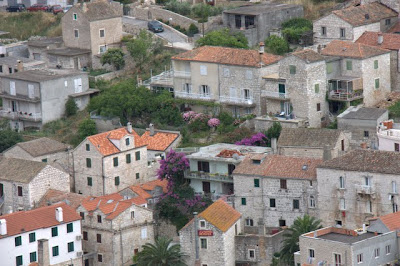



Two: Catamaran from Hvar Town, Hvar Island to Ubli, Lastovo Island
- We took a ferry from Hvar Town to Ubli, the main port on Lastovo Island. From Ubli, you can catch a shuttle bus to Lastovo Town and vice versa.
- Lastovo only has about 800 people total on the island. We knew we had picked a less touristy spot when even most of the Croatians we had met had never been to Lastovo. The island is beautiful, with much of it covered in farmland, mountains or vineyards.
- Although the ferry can take up to five hours from Split to Lastovo, the trip is under two hours if you break it up with a trip to Hvar or Korcula. Plus, there is a fast catamaran (which we took) that reduces the time even further.
- We weren’t sure if there would be Grannies greeting us on Lastovo, so we booked ahead by scouring the Internet. We were right; there was not a single Granny. There is only one hotel on the island. With prices over $100 a night at the hotel, we were glad we found private accommodation in advance. That being said, if you brought a rental car over to the island on the car ferry, it would be pretty easy to find private accommodations by driving up to places labelled konobas and knocking. Many of the konobas have rooms available because they primarily focus on getting sailboats to dock and feeding the sailboat crowds in their restaurants. Without a car, we recommend booking something in advance and arranging for pick up at the ferry dock in Ubli or the bus stop in Lastovo Town.
- It is best not to stay in Ubli (somewhat bland, from what we saw) or Lastovo Town (inland). Without a car, we didn’t get to check out Pasadur, a spot where some rooms can be found. We really liked Zaklopatica Bay, but it is small. The bay is lined with private houses that rent rooms, run small restaurants, and rent dock space to sail boats. Make sure you get a room with a balcony, as the views over the bay are amazing.
- Most (if not all) of the restaurants are not open for breakfast or lunch, so either bring provisions, rent a scooter to ride into Lastovo Town to pick up supplies, or arrange for meals in advance with your host. Other than bring yogurt for breakfast, we did none of those things and almost were caught without lunch. Luckily, the owners of our konoba opened for lunch especially for us.
- Without a car, you are at the mercy of the restaurants in the bay for dinner. Fortunately, all of our meals were tasty (albeit a little pricier than we normally like to spend). We ate at Konoba Santor, where we were staying, as well as Augusta Insula, a popular konoba a few doors down.
- One of the konobas two doors down rented scooters, so we took advantage. Having never driven a scooter before, we ended up wussing out about an hour into the ride and didn’t explore nearly as much of the island as we intended.
- We got the sense that everyone on the island knew everyone else. The island is so small that children live on one of the larger islands or in Split during high school in order to attend school.

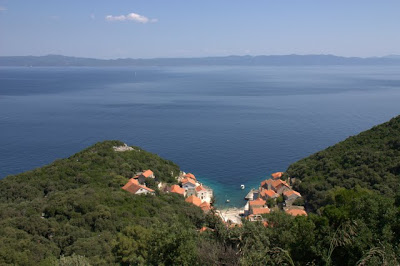

Three: Ferry from Ubli, Lastovo Island, to Vela Luka, Korcula Island
- Korcula is the birthplace of Marco Polo! Many memories of calling out as a kid, Marco! Polo!
- From Vela Luka, we rode a bus through Korcula’s windy roads for about 40 minutes to get to Korcula Town. Again, the buses are timed to coincide with the ferries.
- Although filled with the ever present tourists like Hvar, Korcula Town is smaller and had a better vibe. Many of the bars, cafes and restaurants play music. We especially liked Treseta, a restaurant we stumbled upon one day as we waited for a bus to take us to the beach. The food is great (supposedly homemade by a Croatian granny!) and various people sat and strummed guitars while we ate.

And finally return to the mainland: Ferry from Korcula Town, Korcula Island, to Dubrovnik





